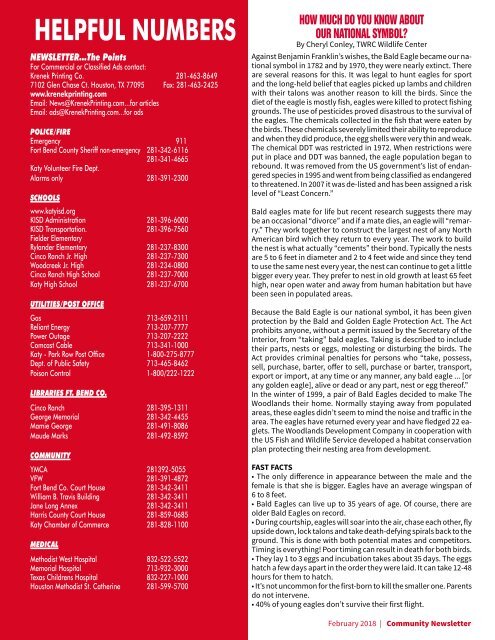The Points February 2018
Create successful ePaper yourself
Turn your PDF publications into a flip-book with our unique Google optimized e-Paper software.
HELPFUL NUMBERS<br />
NEWSLETTER...<strong>The</strong> <strong>Points</strong><br />
For Commercial or Classified Ads contact:<br />
Krenek Printing Co. 281-463-8649<br />
7102 Glen Chase Ct. Houston, TX 77095 Fax: 281-463-2425<br />
www.krenekprinting.com<br />
Email: News@KrenekPrinting.com...for articles<br />
Email: ads@KrenekPrinting.com...for ads<br />
POLICE/FIRE<br />
Emergency 911<br />
Fort Bend County Sheriff non-emergency 281-342-6116<br />
281-341-4665<br />
Katy Volunteer Fire Dept.<br />
Alarms only 281-391-2300<br />
SCHOOLS<br />
www.katyisd.org<br />
KISD Administration 281-396-6000<br />
KISD Transportation. 281-396-7560<br />
Fielder Elementary<br />
Rylander Elementary 281-237-8300<br />
Cinco Ranch Jr. High 281-237-7300<br />
Woodcreek Jr. High 281-234-0800<br />
Cinco Ranch High School 281-237-7000<br />
Katy High School 281-237-6700<br />
UTILITIES/POST OFFICE<br />
Gas 713-659-2111<br />
Reliant Energy 713-207-7777<br />
Power Outage 713-207-2222<br />
Comcast Cable 713-341-1000<br />
Katy - Park Row Post Office 1-800-275-8777<br />
Dept. of Public Safety 713-465-8462<br />
Poison Control 1-800/222-1222<br />
LIBRARIES FT. BEND CO.<br />
Cinco Ranch 281-395-1311<br />
George Memorial 281-342-4455<br />
Mamie George 281-491-8086<br />
Maude Marks 281-492-8592<br />
COMMUNITY<br />
YMCA 281392-5055<br />
VFW 281-391-4872<br />
Fort Bend Co. Court House 281-342-3411<br />
William B. Travis Building 281-342-3411<br />
Jane Long Annex 281-342-3411<br />
Harris County Court House 281-859-0685<br />
Katy Chamber of Commerce 281-828-1100<br />
MEDICAL<br />
Methodist West Hospital 832-522-5522<br />
Memorial Hospital 713-932-3000<br />
Texas Childrens Hospital 832-227-1000<br />
Houston Methodist St. Catherine 281-599-5700<br />
HOW MUCH DO YOU KNOW ABOUT<br />
OUR NATIONAL SYMBOL?<br />
By Cheryl Conley, TWRC Wildlife Center<br />
Against Benjamin Franklin’s wishes, the Bald Eagle became our national<br />
symbol in 1782 and by 1970, they were nearly extinct. <strong>The</strong>re<br />
are several reasons for this. It was legal to hunt eagles for sport<br />
and the long-held belief that eagles picked up lambs and children<br />
with their talons was another reason to kill the birds. Since the<br />
diet of the eagle is mostly fish, eagles were killed to protect fishing<br />
grounds. <strong>The</strong> use of pesticides proved disastrous to the survival of<br />
the eagles. <strong>The</strong> chemicals collected in the fish that were eaten by<br />
the birds. <strong>The</strong>se chemicals severely limited their ability to reproduce<br />
and when they did produce, the egg shells were very thin and weak.<br />
<strong>The</strong> chemical DDT was restricted in 1972. When restrictions were<br />
put in place and DDT was banned, the eagle population began to<br />
rebound. It was removed from the US government’s list of endangered<br />
species in 1995 and went from being classified as endangered<br />
to threatened. In 2007 it was de-listed and has been assigned a risk<br />
level of “Least Concern.”<br />
Bald eagles mate for life but recent research suggests there may<br />
be an occasional “divorce” and if a mate dies, an eagle will “remarry.”<br />
<strong>The</strong>y work together to construct the largest nest of any North<br />
American bird which they return to every year. <strong>The</strong> work to build<br />
the nest is what actually “cements” their bond. Typically the nests<br />
are 5 to 6 feet in diameter and 2 to 4 feet wide and since they tend<br />
to use the same nest every year, the nest can continue to get a little<br />
bigger every year. <strong>The</strong>y prefer to nest in old growth at least 65 feet<br />
high, near open water and away from human habitation but have<br />
been seen in populated areas.<br />
Because the Bald Eagle is our national symbol, it has been given<br />
protection by the Bald and Golden Eagle Protection Act. <strong>The</strong> Act<br />
prohibits anyone, without a permit issued by the Secretary of the<br />
Interior, from “taking” bald eagles. Taking is described to include<br />
their parts, nests or eggs, molesting or disturbing the birds. <strong>The</strong><br />
Act provides criminal penalties for persons who “take, possess,<br />
sell, purchase, barter, offer to sell, purchase or barter, transport,<br />
export or import, at any time or any manner, any bald eagle ... [or<br />
any golden eagle], alive or dead or any part, nest or egg thereof.”<br />
In the winter of 1999, a pair of Bald Eagles decided to make <strong>The</strong><br />
Woodlands their home. Normally staying away from populated<br />
areas, these eagles didn’t seem to mind the noise and traffic in the<br />
area. <strong>The</strong> eagles have returned every year and have fledged 22 eaglets.<br />
<strong>The</strong> Woodlands Development Company in cooperation with<br />
the US Fish and Wildlife Service developed a habitat conservation<br />
plan protecting their nesting area from development.<br />
FAST FACTS<br />
• <strong>The</strong> only difference in appearance between the male and the<br />
female is that she is bigger. Eagles have an average wingspan of<br />
6 to 8 feet.<br />
• Bald Eagles can live up to 35 years of age. Of course, there are<br />
older Bald Eagles on record.<br />
• During courtship, eagles will soar into the air, chase each other, fly<br />
upside down, lock talons and take death-defying spirals back to the<br />
ground. This is done with both potential mates and competitors.<br />
Timing is everything! Poor timing can result in death for both birds.<br />
• <strong>The</strong>y lay 1 to 3 eggs and incubation takes about 35 days. <strong>The</strong> eggs<br />
hatch a few days apart in the order they were laid. It can take 12-48<br />
hours for them to hatch.<br />
• It’s not uncommon for the first-born to kill the smaller one. Parents<br />
do not intervene.<br />
• 40% of young eagles don’t survive their first flight.<br />
2 <strong>February</strong> <strong>2018</strong> | Community Newsletter

















